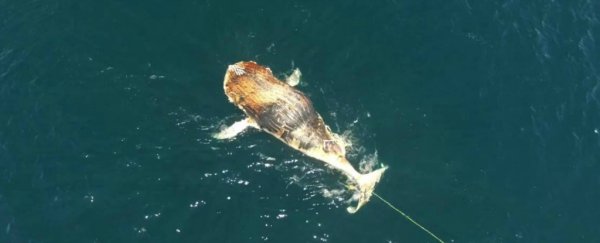A dead whale named Wally has washed up on a beach in southern California for at least the fifth time this month.
Despite multiple attempts to tow the female humpback whale out to sea to decompose naturally, her body just keeps on coming back to shore, and frustrated authorities have now started cutting her body up into little pieces so they can send it to landfill instead.
"This is kind of a crazy situation in that it keeps coming back," Justin Greenman, assistant stranding coordinator for California with the National Oceanic and Atmospheric Administration (NOAA) told Press Telegram.
So what the heck is going on with the repeat appearances? As Greenman explains, it all comes down to a series of unfortunate logistical errors that have failed to get Wally's body far enough from shore to escape the currents and tides that pull her back in.
Poor Wally 🙁
In her better days, the humpback whale was well known around Newport Beach in southern California after aerial footage last year showed beautiful rainbow-hued spray coming from her blow hole. You can check it out below:

But on June 30th this year, when revellers began showing up to Dockwailer State Beach in Los Angeles to celebrate the July 4th long weekend, Wally's decomposing carcass washed up on the beach.
The ideal course of action in this situation is to leave the carcass there to decompose naturally - but according to NBC Los Angeles "the smell was pretty awful", and being around 90 metres (100 yards) away from an RV park on the biggest holiday weekend of the year, leaving Wally there wasn't really an option.
So the NOAA decided to tow her out to sea so that she could decompose in the ocean - potentially helping to feed other marine organisms in the process - which is the second best outcome.
To figure out how far to take her, the team modelled currents and winds, and determined that she'd need to be towed around 48 km (30 miles) in order for her bloated carcass to avoid being dragged back into the beach.
So far, so good. Except none of the lifeguard vessels at Dockweiler State Beach were large enough to have the fuel to drag the 35- to 40-tonne Wally out that far and then make the return journey… so they only took her roughly 24 km (15 miles) and hoped it would be far enough.
That might not sound that far, but the journey still took five hours. "It was something that was extremely strenuous to remove," the county's lifeguard captain, Kenichi Haskett, told Press Telegram.
Unfortunately, the effort was in vain, and a few days later, Wally was spotted near the beach at San Pedro.
Lifeguards towed her out to sea again, but pretty soon she washed up on Newport Beach, where lifeguards spent a whole day yanking her back out to sea… and then did the same thing again the next day after a southerly wind brought her back.
You can see footage of that below:

She was then spotted at Dana Point, where Harbour Patrol intercepted her floating body, and San Clemente State Beach, before washing up on Grandview Beach in Encinitas.
Recent attempts to get Wally back in the water using a bulldozer have since failed, with her weight popping two of the vehicle's tyres.
The National Marine Fisheries have now given permission for officials to cut up Wally's body and transport it to a San Diego landfill to get rid of it, as 10 News reports. The process was scheduled to begin at 5am on Monday.
It's a pretty sad outcome, but let's hope the experience of Wally helps life guards deal with whale carcasses better in future.
A big part of the problem, in addition to the body not being towed out far enough, is that the NOAA didn't have the chance to perform a full necropsy on Wally - which is when they open the whale up and degas it before removing it from a beach - something that makes it much more likely to stay away from the shore.
"Obviously, it works better when the animal can be opened up and degassed," said Greenman.
Let's hope in future officials get things right the first time, because the Wally experience has been pretty awful for everyone involved.
